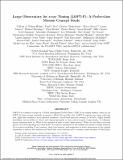Large Observatory for x-ray Timing (LOFT-P): a Probe-class mission concept study
Author(s)
Chakrabarty, Deepto
DownloadLarge observatory.pdf (575.7Kb)
PUBLISHER_POLICY
Publisher Policy
Article is made available in accordance with the publisher's policy and may be subject to US copyright law. Please refer to the publisher's site for terms of use.
Terms of use
Metadata
Show full item recordAbstract
LOFT-P is a mission concept for a NASA Astrophysics Probe-Class (<$1B) X-ray timing mission, based on the LOFT M-class concept originally proposed to ESAs M3 and M4 calls. LOFT-P requires very large collecting area, high time resolution, good spectral resolution, broad-band spectral coverage (2-30 keV), highly flexible scheduling, and an ability to detect and respond promptly to time-critical targets of opportunity. It addresses science questions such as: What is the equation of state of ultra dense matter? What are the effects of strong gravity on matter spiraling into black holes? It would be optimized for sub-millisecond timing of bright Galactic X-ray sources including X-ray bursters, black hole binaries, and magnetars to study phenomena at the natural timescales of neutron star surfaces and black hole event horizons and to measure mass and spin of black holes. These measurements are synergistic to imaging and high-resolution spectroscopy instruments, addressing much smaller distance scales than are possible without very long baseline X-ray interferometry, and using complementary techniques to address the geometry and dynamics of emission regions. LOFT-P would have an effective area of >6 m[superscript 2], > 10x that of the highly successful Rossi X-ray Timing Explorer (RXTE). A sky monitor (2-50 keV) acts as a trigger for pointed observations, providing high duty cycle, high time resolution monitoring of the X-ray sky with ~20 times the sensitivity of the RXTE All-Sky Monitor, enabling multi-wavelength and multimessenger studies. A probe-class mission concept would employ lightweight collimator technology and large-area solid-state detectors, segmented into pixels or strips, technologies which have been recently greatly advanced during the ESA M3 Phase A study of LOFT. Given the large community interested in LOFT (>800 supporters*, the scientific productivity of this mission is expected to be very high, similar to or greater than RXTE (~ 2000 refereed publications). We describe the results of a study, recently completed by the MSFC Advanced Concepts Office, that demonstrates that such a mission is feasible within a NASA probe-class mission budget.
Date issued
2016-07Department
Massachusetts Institute of Technology. Department of Physics; MIT Kavli Institute for Astrophysics and Space ResearchJournal
Proceedings of SPIE 9905, Space Telescopes and Instrumentation 2016: Ultraviolet to Gamma Ray
Publisher
Society of Photo-Optical Instrumentation Engineers (SPIE)
Citation
Wilson-Hodge, Colleen A. et al. “Large Observatory for X-Ray Timing (LOFT-P): A Probe-Class Mission Concept Study.” SPIE 9905, Space Telescopes and Instrumentation 2016: Ultraviolet to Gamma Ray, 26 June, 2016, Edinburgh, Scotland, United Kingdom, SPIE, 2016. © 2016 SPIE
Version: Final published version
ISBN
9781510601895